So I was quite disappointed when my Striped Knit Top looked great and fit terrible. Perplexed because my woven block fits much better. Couldn’t understand, since the knit block is a fabrication from the woven block. Have I made that many changes to my woven block? I had noticed that the last few summer knits I made didn’t fit as well as I liked so maybe it was time to revisit its fit. I began by comparing the knit to the woven block. Holy cow, these are nothing at all alike. Well maybe the additional CF length, but otherwise; Holy Cow! Then I remembered, I did not develop the knit block from the woven block. I developed the knit block from Connie Crawford 5215. And it wasn’t easy. I made 3 test garments. I was about to give up on Test #3 when it fit. It just fit. I remember distinctly being confused because the last change I made shouldn’t have made a difference. But it did.
Confession to make. I’m no longer enamoured with Connie Crawford’s drafting. Other than CS1204 and 5538, none of her patterns have fit me without extraordinary effort. It seems that the changes she makes to improve fit make it more difficult for me. I have to figure out what she has done and then undo it. She’s not alone in this category. I’m finding that most of the patterns which say “I’ve made all the changes for you” require the same kind of effort of my part. I seem to be much better off starting with a consistent standard block like Ottobre Design or Burda and then applying my personal changes. The only thing better is starting with my fitted block and adding details. Please hold the poison pens. I don’t mean to bad mouth any of the pattern companies. I realize that due to age, posture and my personal health issues, I can’t be easily fit to the standard that I desire. The only RTW I buy has 8″ of stretch. It’s safe to say those garments don’t fit so much as stretch into place. Starting with my block and drafting seems to be my best choice.
I’m doing so much drafting now, that I decided to adapt my woven block rather than start over with a block that I struggled to fit. Easy to do, I copied my woven block with all it’s notches and darts. Then I dug out my notes from Craftsy Class “Pattern Making for Knits”. The PDF for this course is worth the entire cost. I won’t share all the details after all the instructor, Judy Jackson, does deserve both credit for the idea and $$$ for her effort. Judy applies a series of tweaks to convert woven pattern to knit. I’ve made so many tweaks to my block that I chose to make only 1 change, folding out 1/4″ length at the armscye. I understand and accept that the circumference probably will need to be adjusted later to accommodate the knit of my choice and that I could find length issues as well. My biggest concern was the darts. I decided to keep the bust dart but move the shoulder and waist darts to the nearest seam. Having been bit before by assuming my changes would not affect length of the seams, I carefully walked side, shoulder and armscyes. (By default my block does not contain CB and CF seams. I add those when desired.) I’m still uncertain about the round back alteration (i.e. is 1/2″ enough or is more needed; how do knit and other stretch fabric affect the amount?) and opted to use the block without an RBA so I could really look at it. About the bust dart, I’d really prefer to have a ‘normal’ looking T-shirt just without the droopy sleeves. However it’s rare a style that looks really good without substantial darting. (The last one I recall is a Burda Dolman Sleeve which was a fully lined sweater knit.) Point being that I may in the future rotate the bust dart, but probably not. I like the way the bust dart smooths out the underarm and side seam. I like that look. If it takes a dart to achieve, well so be it.
My fabric is an elderly knit. I bought it about 4 years ago during a Nebraska Junk Jaunt. I look for fabrics on these trips. I find the Nebraskans hold onto good fabrics. Even if they don’t sew. Somehow mothers, aunts, sisters who do sew produce the impression that good fabrics are to be treasured. They bring the fabrics out hoping to find that person who can appreciate fabrics. I think they’re happier than I am when I choose to purchase. So I’ve had the fabric 4 years, but it’s older than that and older knits are and behave differently from current knits. This 100% cotton stretches 30% and then recovers. It’s heavy not one of these light-weight, transparent fabrics that fashion in banking on (and losing their shirts over). It’s a good fabric but more appropriate for late fall and winter. I probably won’t be wearing it much during the warmer autumn weather I’m enjoying. I made full pieces because it has uneven black and purple stripes with an occasional turquoise strip thrown in the mix. Didn’t care for the addition of turquoise, so I arranged my pattern pieces to avoid it. Still of the mind to do interesting work with stripes, I separated the sleeve at about the elbow and placed the new lower half cross grain. This was no my own idea. I was inspired by this top
(no idea where or when I cut this pic).
In the mood for a little embroidery, I chose this geometric
and played a little. The original (above) has 3 colors. My finished has only 2. I put one motif on each sleeve and 3 across the chest.
I decided to try a little different neckline finish. I know lots of people use the turn-and-stitch neckline finish especially with knits (because they don’t ravel) but I’ve always hated it. I like a finished edge. Besides knit may look nice to start with but it can run and become ragged. I taped both shoulders then serged the left shoulders together. I basted clear elastic to the wrong side around the neckline. Basted because I wanted to be able to rip it out and adjust as needed. I wanted my neckline to lie flat; control the tendency of knit to ‘stretch-out’ but I didn’t want it gathered. Since I basted, I was right the first time. I serged the neckline, turned and top stitched. In retrospect, I could have basted, turned and cover-stitched which would have saved me a step.
Happily, I now have a neatly finished neckline and really cute embroidery:
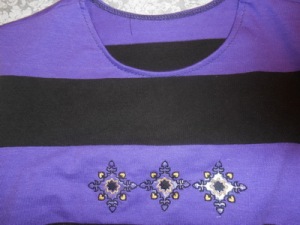
I tried a different ‘at the SM’ adjustment for my shoulders. I trimmed the back, right-shoulder evenly 1/4″, then serged it to the front right shoulder. I actually did this before I turned and stitched the neckline because that order makes for a much smoother, neater neckline i.e. no possibility of a jagged shoulder at the neckline. The rest of the sewing is pretty standard ie. serge the sleeves together (they were in two parts), serge sleeves into armscyes, serge finish side seams, stitch side seams and cover-stitch hems. And it was all pretty fast. I really wanted to get to the first try-on to check the fit.
Firstly, I think this is really cute. I am going to wear it with pride. My stripes are too big to really highlight the different stripe direction on the sleeve. Which is not bad. It makes this style decision re-usable. I’m sharing final pics, but I did do a fitting. After the fitting, I increased the bust darts 1/8″ which eliminated most of the underbust wrinkles on the left but I still have one of the right.
That may be because of the way I did my shoulder adjustment. . IMO, the shoulders are what they are going to be because that neckline is basted, serged and top stitched. I’m not undoing and doing that again. I expected to need to make the circumference smaller, less, because this is a knit fabric cut from a woven block. I first stitched the side seams at 3/4″. Took that out and stitched at the default woven SA of 1/2″. Frankly, there is a possibility I could need to let the back out a little more.
Before any of you suggest a sway-back alteration, look at the arrows. The hem is rising. A sway-back corrects when the back is too long between shoulder and waist. In which case the hem will sit evenly but fabric will pool mid-back. On my back, the hem is being pulled up and the pooling occurring above that. It could be that I need more ease (look at the front tummy and side views). It could be that thing called ‘velcro butt’ wherein the fabric sticks to a prominent backside and refuses to stay down even though there is plenty of ease.
I’m actually more interested in the back between the shoulder blades. I do think that an RBA is justified and thanks to my friends at SG and our discussion, I’ll feel confident adding that to my new sloper for the next knit top.
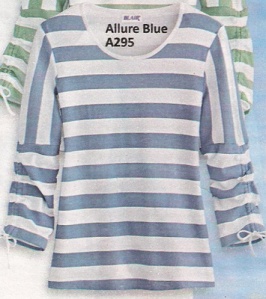
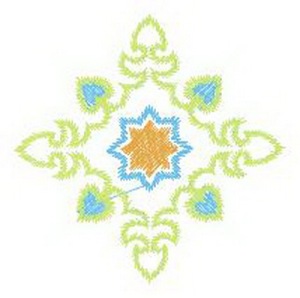
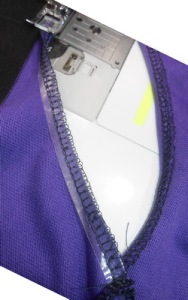
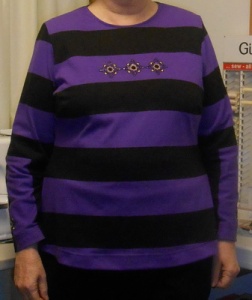
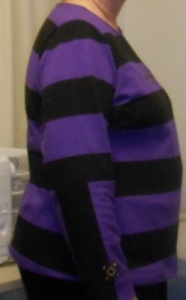
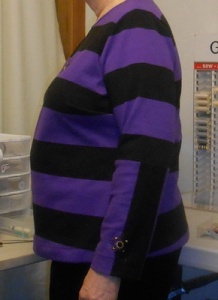
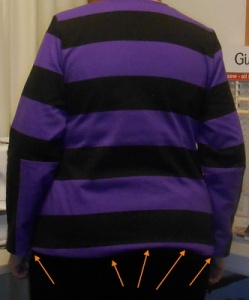
I love your inspiration top, and how nicely you interpreted it in fall/winter colors and cotton knit. Don’t worry about the back because that’s the nature of the knit, and it would stick even if you had 3X the ease.
LikeLike
Wow thanks terry for this info ” Don’t worry about the back because that’s the nature of the knit, and it would stick even if you had 3X the ease.” Never realized this.
bev
LikeLike